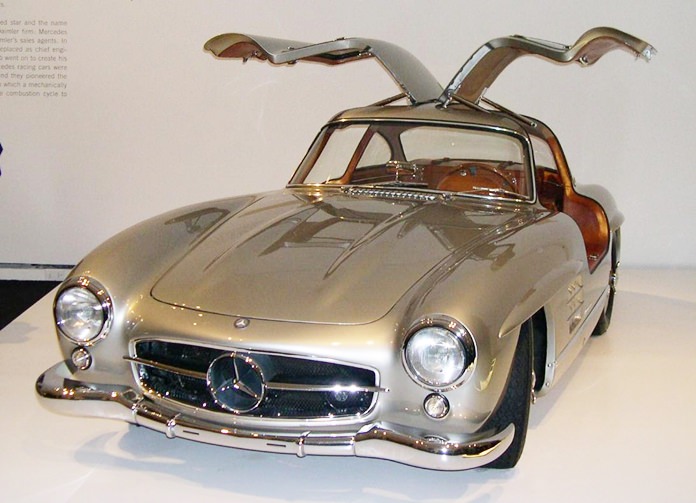This list of the supposed 10 best looking cars of all time came out of America, so they can be excused for the inclusion of a couple of Yankee cars. The list was:
- 1954 Mercedes-Benz 300SL
- 1961 Ferrari 250 GT California
- 1963 Chevrolet Corvette
- 1964 Aston Martin DB5
- 1965 Jaguar E-Type
- 1966 Ford GT40
- 1967 Ferrari 275 GTB/4
- 1970 Dodge Challenger R/T
- 1971 Lamborghini Miura SV
- 1973 Porsche Carrera RS
Like the W194 Grand Prix car, the 300 SL borrowed its 3.0 liter overhead cam straight 6 from the regular four-door 300 (W189 “Adenauer”) luxury tourer introduced in 1951. The engine was canted to the right at forty-five-degrees to fit under the 300SL’s lower roof line.

A groundbreaking Bosch mechanical direct fuel injection was installed, boosting power almost 25 percent over the Grand Prix car’s. Derived from the DB 601 V12 used on the high-powered Messerschmitt Bf 109E fighter of World War II, it raised output from 130 kW; 177 PS (175 hp) to 160 kW; 218 PS (215 hp), almost double that of the original Type 300 sedan’s 86 kW; 117 PS (115 hp). The result was a top speed of up to 260 km/h (160 mph) depending on gear ratio and drag, making the 300 SL the fastest production car of its time.
However, unlike today’s electrically powered fuel injection systems, the 300 SL’s mechanical fuel pump would continue to inject gasoline into the engine during the interval between shutting off the ignition and the engine’s coming to a stop; this unburned gasoline washed lubricating oil from the cylinder walls, which not only left them unprotected in affected areas during start-up but would dilute the engine’s entire oil supply if the car was not driven hard or long enough to reach a sufficient temperature to evaporate the gas out of the oil. To reduce the dilution of oil by gasoline when stopping the engine, the owner’s manual advised “turn the ignition key to the left while idling. Do not on any account try to stop the engine at a higher speed.”
Clutch operation was initially very heavy, remedied by an improved clutch arm helper spring which reduced pedal force. From March 1963 to the end of production later that year, a light alloy crankcase was used on a total of 209 vehicles.
Aerodynamics were not well developed immediately post-war, but the Mercedes engineers realized that aerodynamics played an important role in the car’s speed, with Mercedes-Benz engineers placing horizontal “eyebrows” over the wheel openings to reduce drag.
Unlike many cars of the 1950’s, steering was relatively precise and the four-wheel independent suspension allowed for a reasonably comfortable ride and markedly better overall handling. However, the rear swing axle, jointed only at the differential, not at the wheels themselves (as VW and Porsche), could be treacherous at high speeds or on imperfect roads due to extreme changes in camber. The enormous fuel tank capacity also caused a considerable difference in handling depending on the quantity of fuel on board.
It was an amazing car for its day and still draws crowds 60 years later.




